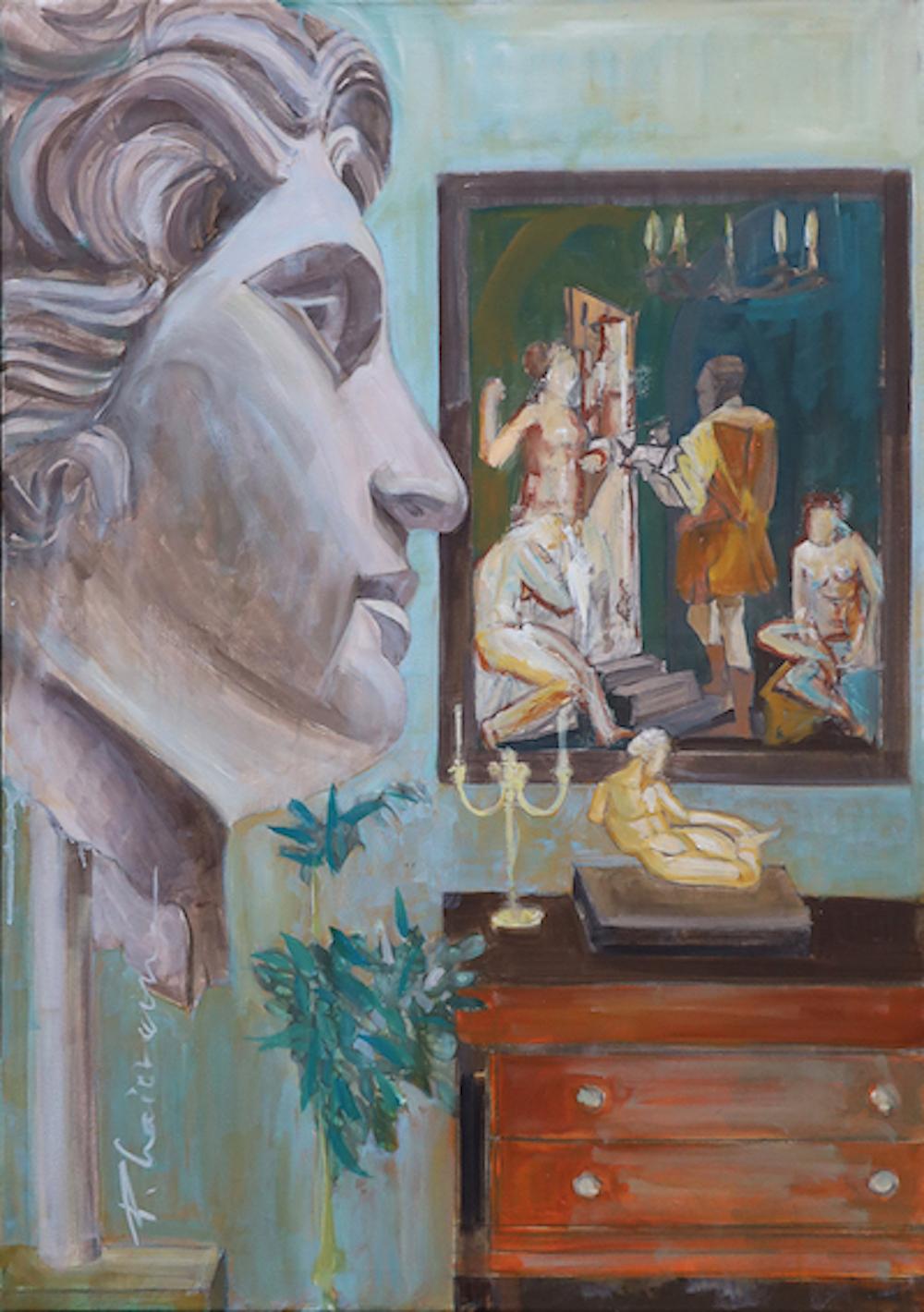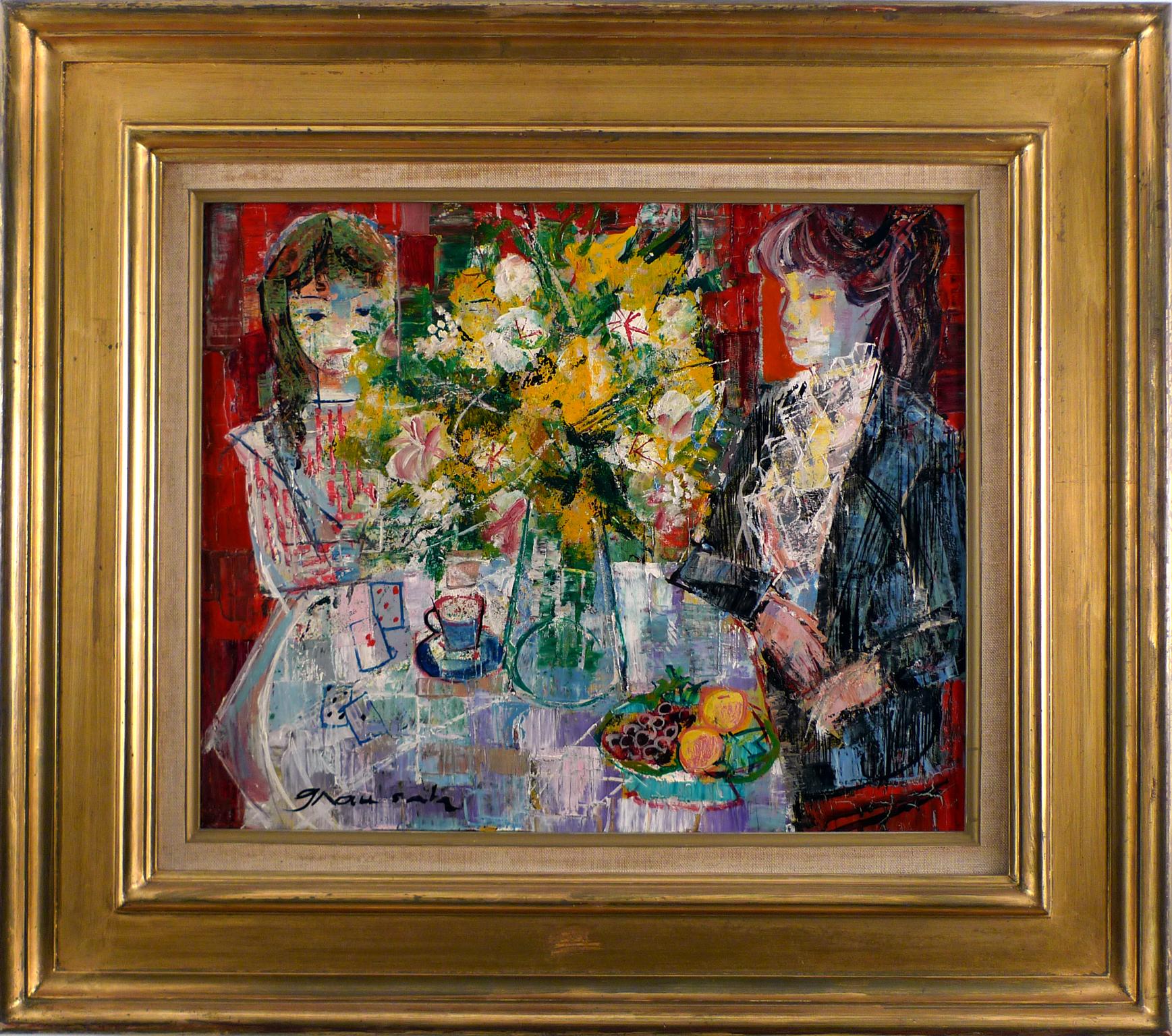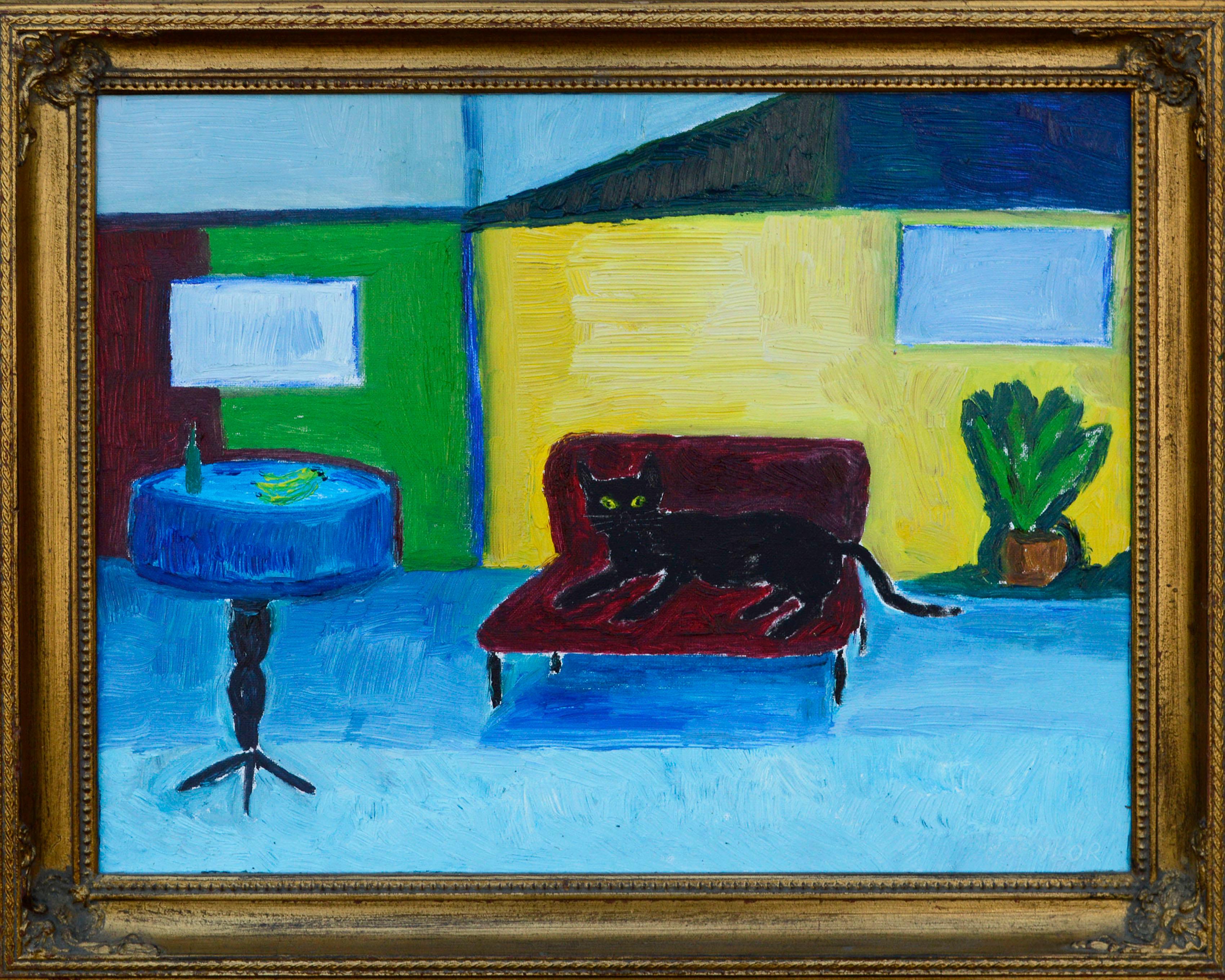Items Similar to Polish French Fauvist Judaica Oil Painting Rabbi at Prayer
Want more images or videos?
Request additional images or videos from the seller
1 of 8
Frederick B. SergerPolish French Fauvist Judaica Oil Painting Rabbi at Prayerc.1940s
c.1940s
About the Item
Genre: Impressionist
Subject: People
Medium: Oil
Surface: Panel
Frederick Serger (given name Frederick Bedrick Sinaberger) was born in 1889 to a family of Jewish manufacturers in the village of Ivancice near Brno Moravia, a province of Czechoslovakia. Showing artistic talent at a young age, he attended art schools in Brno, Vienna, and Munich. During World War I, Serger joined the Austrian Army and served in the Balkans. Once his service ended, he traveled to Paris where he resumed his art training and eagerly joined the Ecole de Paris (School of Paris) artists’ movement. During this period, he was greatly influenced by the Impressionist, Post-Impressionist, and Expressionist movements.
While living in Paris, he met and married Helen Spitzer. Serger and his young wife moved from Paris to Scoczow, a city on the Polish-Czech border. They remained in Scoczow for 12 years and he continued to work as an artist, exhibiting in museums in Cracow and Warsaw, Poland. He also showed at the Paris Salon de Tuilleries and the Salon d’Automne with exhibitions protesting the French Academy’s Salon system. A high point in Serger’s career was an exhibition at the famed Bernheim-Jeune in Paris. The Bernheim-Jeune was known for displaying the artwork of premier artists such as Pablo Picasso and Paul Cezanne. Finally, in 1937, the City of Paris Museum purchased one of his paintings to be part of their collection.
During the onset of World War II, the Sergers moved several times, possibly in reaction to widespread Anti-Semitism during this period. They lived briefly in England, Panama, Guatemala, and Mexico. Finally, in 1941, they established permanent residence in Manhattan, New York. Serger set up a studio along 57th Street in Manhattan. Once again, he began painting prolifically and exhibiting his artwork in such prestigious galleries as Schoneman, Van Diemen-Lilienfeld and John Heller. His pieces were also displayed in major museums including the De Young Museum in San Francisco, the Museum of New Mexico in Santa Fe, the Springfield Art Museum and the Butler Institute of American Art in Ohio.
He studied art in Vienna, and in Munich with the Viennese Secessionists, served with the Austrian Army in World War One, went to Paris where he studied art and became part of the School of Paris (Ecole De Paris) movement, married Helen Spitzer, ( later Helen Serger owner of the Helen Serger, La Boetle Galleries in Manhattan) moved to Scoczow in Poland
until 1939, meanwhile exhibiting at many museums in Warsaw, Cracow, Salon de Tuilleries and at the famous Salon d'Automme, both in Paris regularly. In
1936 he had a one-man show at Salon and at Bernheim Jeune in Paris at a gallery historically noted for exhibiting many of the most important modern
painters such as Picasso and Cezanne. In 1937 the Museum of the City of Paris purchased a Serger from the Salon d'Automme. In 1939 he moved to
England and from there to Panama, Guatemala, and Mexico. In 1941 he established a studio on 57th St. in Manhattan and commenced a long career of exhibiting in New York Galleries such as, Lillenfelt Galleries, John Heller, Schoneman, a one-man show at De Young Museum in San Francisco and at the Museum of New Mexico in Santa Fe, at the Springfield Art Museum, and at the Butler Institute of American Art in Ohio; Serger participated in group
shows at the Mint Museum in Charlotte, Springfield Museum in Mass., Isaac Delgado Museum in New Orleans, Academy of Fine Arts in Hartford,
Norton Gallery in West Palm Beach, Carnegie Institute of Pittsburgh, Corcoran Gallery in Washington D.C., University of Illinois in Urbana,
Pennsylvania Academy of Art, Philadelphia, Detroit Institute of Art, Pennsylvania Academy of Fine Art, Philadelphia, Whitney Museum in New York andin countless other exhibits during the twenty-five years he lived and worked in New York. A listed Woodstock, NY artist. His biography is included in Who is Who in World Jewry and articles on his work appeared in many publications. FREDERICK SERGER HIS LIFE AND WORK by George Stiles
published by Schoneman, New York in 1962. He joined the Ecole de Paris (School of Paris) artists’ movement. During this period, he was greatly influenced by the Impressionist, Post-Impressionist, and Expressionist movements.
- Creator:Frederick B. Serger (1889-1965, American)
- Creation Year:c.1940s
- Dimensions:Height: 20 in (50.8 cm)Width: 16 in (40.64 cm)
- Medium:
- Movement & Style:
- Period:
- Condition:minor wear. paint loss around edge where it was under frame.
- Gallery Location:Surfside, FL
- Reference Number:1stDibs: LU38213146452
About the Seller
4.9
Platinum Seller
These expertly vetted sellers are 1stDibs' most experienced sellers and are rated highest by our customers.
Established in 1995
1stDibs seller since 2014
1,546 sales on 1stDibs
Typical response time: 1 hour
- ShippingRetrieving quote...Ships From: Surfside, FL
- Return PolicyA return for this item may be initiated within 3 days of delivery.
More From This SellerView All
- the Rabbi's Cheder Test Hungarian Judaica Oil PaintingBy Nandor Vydai BrennerLocated in Surfside, FLRare Pre World War II (Pre Holocaust) Judaica Art. European Judaic art from this period is exceedingly rare. Nandor Brenner Viday, Born in Budapest, Hungary in 1903, date of death u...Category
Early 20th Century Post-Impressionist Figurative Paintings
MaterialsCanvas, Oil
- Rare French, Paris 1935 Judaica Oil Painting Rabbis Studying S. FleischmanLocated in Surfside, FLRare Judaica Art. Jewish genre scene. In the tradition of Moritz Oppenheim, Isidor Kauffman and Maurycy Gottlieb and later of Tully Filmus, Zalman Kleinman and Itshak Holtz the artist captures this Jewish scene with a particular sensitivity. Part of the Ecole De Paris The term "School of Paris" was used in 1925 by André Warnod (fr) to refer to the many foreign-born artists who had migrated to Paris. School of Paris artists were progressively marginalized. Beginning in 1935 art publications no longer wrote about Marc Chagall, just magazines for Jewish audiences, and by June 1940 when the Vichy government took power, School of Paris artists could no longer exhibit in Paris at all. The artists working in Paris between World War I and World War II experimented with various styles including Cubism, Orphism, Surrealism and Dada. Foreign and French artists working in Paris included Jean Arp, Joan Miró, Constantin Brâncuși, Raoul Dufy, Tsuguharu Foujita, artists from Belarus like Michel Kikoine, Pinchus Kremegne, and Jacques Lipchitz, the Polish artist Marek Szwarc and others such as Russian-born prince Alexis Arapoff. A significant subset, the Jewish artists, came to be known as the Jewish School of Paris or the School of Montparnasse. The "core members were almost all Jews, and the resentment expressed toward them by French critics in the 1930s was unquestionably fueled by anti-Semitism." One account points to the 1924 Salon des Indépendants, which decided to separate the works of French-born artists from those by immigrants; in response critic Roger Allard (fr) referred to them as the School of Paris. Jewish members of the group included Emmanuel Mané-Katz, Chaim Soutine, Adolphe Féder, Chagall, Moïse Kisling, Maxa Nordau...Category
Mid-20th Century Post-Impressionist Figurative Paintings
MaterialsOil, Board
- Wisdom of King Solomon Rare Biblical Hungarian Judaica Oil PaintingBy Anton PeczelyLocated in Surfside, FLRare Pre World War II (Pre Holocaust) Judaica Art. European Judaic art from this period is exceedingly rare. Péczely Antal Anton 1891 - 1963 Known for his Jewish genre scenes, Chess scenes and other early 20th Century salon style paintings. In the tradition of Moritz Oppenheim...Category
Early 20th Century Post-Impressionist Figurative Paintings
MaterialsOil, Board
- Blessing of the Tzadik (Rebbe) Rare Hungarian Judaica Oil PaintingBy Anton PeczelyLocated in Surfside, FLRare Pre World War II (Pre Holocaust) Judaica Art. European Judaic art from this period is exceedingly rare. Péczely Antal Anton 1891 - 1963 Known for his Jewish genre scenes, Chess scenes and other early 20th Century salon style paintings. In the tradition of Moritz Oppenheim...Category
Early 20th Century Post-Impressionist Figurative Paintings
MaterialsOil, Board
- Japanese Fauvist Colorful Oil Painting Chinese Ceramic Jars with Fan and AppleLocated in Surfside, FLYoshio Aoyama (Japanese, 1894-1996) "Nature Morte". Oil on canvas. 1981. Signed 'Aoyama' (upper left). Signed and titled 'Nature Morte' verso. 15" x 18" ...Category
1980s Fauvist Interior Paintings
MaterialsCanvas, Oil
- Large French Expressionist Oil Painting, Girl, Poupèe, the Doll, Ecole de ParisLocated in Surfside, FLSigned on recto and signed verso, titled, and inscribed Montmartre by the artist. This is a large colorful expressionist painting of a girl doll with long blonde or ginger redhead pigtails. It is titled Poupee 1925 and depicts an Art Deco era flapper girl in a beret. Roger Crusat (French Expressionist artist, poet and lithographer) is known for ballet troupe set design and theatre backdrop painting and architectural motifs. Roger Crusat was born in 1917 in Roussillon, Provence, France. Crusat's early works depict the colorful countryside of Provence in the South of France, As a young man Crusat performed many jobs in the troupe, designing costumes, and even dancing. But, most important, he painted the scenery for the troupe's performances. It was while working in this capacity that he learned the essentials of scenery painting that remain evident in his mature work. Crusat was a student of Andre Fons-Godail at Beaux-Arts in Perpignan when he was called to serve in World War II. After being wounded in 1940, he returned to study under Rene Jaudon at Beaux-Arts in Paris. Crusat was known by his contemporaries as "the Catalan painter of Montmartre" where he lived with his wife until his death in 1994. Cracked and peeling walls framed by rusting water pipes are a common sight in Montmartre. What others considered unnecessary, Crusat included. Water pipes were his cherished motif. Supposed by some to be a symbol of decay and monotony, Crusat's Impressionist water pipes like arteries in the body, convey life. Crusat won the prestigious Prix Populiste for his "Descente d'Eau" (Water Pipes) in 1956. Crusat's mature work retains the essentials of good scenery painting. Intricate detail will not be found, but broad, solid abstract shapes abound. His subtle colors, dense in texture, are meant to compliment his subjects, not distract from them. The critics considered him a lyric expressionist and a "painter of Man" in his portrayal of the anguish of daily life and the regrets of the past. Crusat exhibited at many of the same Salons as the post-impressionists and expressionists. Salon des Independants was co-founded by Georges Seurat. Degas had only one exhibition during his lifetime, and it was at the Galerie Durand Ruel in Paris. Gauguin had also exhibited his Tahitian paintings. Crusat's works were exhibited there in 1955. SELECT AWARDS 1954 Le Prix de la Jeune Peintre 1955 Prix des Amateurs d'Art & des Collectionneurs, Galerie Gazette des Beaux Arts, 140 rue Faubourg St. Honore, Paris Les Jardins des Abbesses purchased by the Republic of France, Prix de la Ville de Marseilles, Prix Othon Friesz 1956 Prix Populiste, Prix de Amedeo Modigliani 1957 Grand Prix International de Vichy, Prix de la Fondation Greenshields 1959 IVeme Grand Prix de Peinture du Festival de Vichy 1967 Le Prix des Amis de Brantôme, Perigord, France 1970 Prix de la Critique Academy de Vernet a Vichy,"La Nuit, Premiere Etude" Roger Crusat, Half-closed shutters , poems enriched with four original lithographs (175 numbered copies) drawn on Henri Deprest's presses on February 13, 1975 , Éditions Matignon 34, 1975. Personal exhibitions Durand-Ruel Gallery, Paris, 1955 [ 1 ] . Galerie Rivière, Paris, november 1958 [ 4 ] . Le Roux and Mathias, auctioneers in Paris, Sale of the Roger Crusat workshop , Hôtel Drouot , Paris, Thursday October 27, 1994 [ 5 ] . Jack's American Bistro, Glens Falls , September- october 2004 [ 6 ] . Collective exhibitions Galerie Roger, Lyon , October 1946 [ 7 ] . Salon des Indépendants , Paris, from 1952 [ 8 ] . Exhibition Discover , Galerie Charpentier , Paris, 1955. Populist Salon, Paris, 1956. Salon des Amis de Brantôme, 1957. Hundred painters and oil - Exhibition on the occasion of the centenary of the first oil drilling , Musée Galliera , october 1958 [ 9 ] . “An artist from Roussillon whose invoice calls for a flattering comparison with that of a Soutine or a Rebeyrolle . Indeed, following their example, he focuses on familiar scenes: Girls on the balcony or in the basket , Laundresses weighing heavily on the iron, draft horses or plucked turkeys, who stand next to a magnificent portrait of a man in a red dressing gown . Hasn't the Prix Populiste already crowned its merits? " - Jean Jacquinot SELECT EXHIBITIONS Galerie La Gentilhommiere, Paris La Salle Arago, Perpignan, Salon des Indépendants, Salon d'Automne Biennale de Menton, Menton Galerie des Jacobins, Lyon Galerie Durand-Ruel, Paris Salon de la Nationale Galerie Bassano, Paris Salon Populiste Salon de Romans Galerie Motte, Geneva, Switzerland Exposition à Quiberville sur Mer - Normandie Galerie Charpentier Salon Confrontation: Bernard Buffet, Roger Crusat, Jean Jansem, Franck Innocent, Jean-Jacques Morvan...Category
Mid-20th Century Expressionist Figurative Paintings
MaterialsCanvas, Oil
You May Also Like
- Looking at the WorldBy Paula CraioveanuLocated in Santa Monica, CAOil on canvasCategory
21st Century and Contemporary Fauvist Interior Paintings
MaterialsCanvas, Oil
- "Les Musiciens", 20th Century Oil on Canvas by Spanish Artist Celso LagarBy Celso LagarLocated in Madrid, ESCELSO LAGAR Spanish, 1891 - 1966 LES MUSICIENS signed "Lagar" (lower right) signed again, located & dated "Lagar / Paris 1928" (on the reverse) oil on canvas 23-3/4 x 28-3/4 inches ...Category
1920s Fauvist Figurative Paintings
MaterialsCanvas, Oil
- Sitting woman and still life oil on canvas paintingBy Jordi CurosLocated in Barcelona, BarcelonaJordi Curós Ventura (1930-2007) - Woman Oil on canvas. Work measurements 77x79 cm. Frame size 81x83 cm. Jordi Curós Ventura (Olot, Girona, March 4, 1930) is a Spanish painter. He t...Category
1980s Fauvist Figurative Paintings
MaterialsOil, Canvas
- bathers (the kiss), female nude figures indoor pool green grey tonesBy Stephen BassoLocated in Brooklyn, NYfemale bathers by visionary artist Stephen BassoCategory
Early 2000s Fauvist Figurative Paintings
MaterialsCanvas, Oil
- Red Couch, Black Cat - Contemporary Fauvist Interior Scene in Primary ColorsBy Jonathan TaylorLocated in Soquel, CAFun and colorful contemporary Fauvist interior scene of a black cat lounging on a red couch in a brightly hued room in primary colors, by Jonathan Taylor (American, b.1966). Signed...Category
2010s Fauvist Interior Paintings
MaterialsCanvas, Oil, Cardboard
- Woman in rocking chair oil on canvas painting fauvism nudeBy Jordi CurosLocated in Barcelona, BarcelonaJordi Curós Ventura (1930-2007) - Woman in rocking chair - Oil on canvas. Work measurements 61x46 cm. Frameless. Jordi Curós Ventura (Olot, Girona, March 4, 1930) is a Spanish paint...Category
1970s Fauvist Figurative Paintings
MaterialsCanvas, Oil


